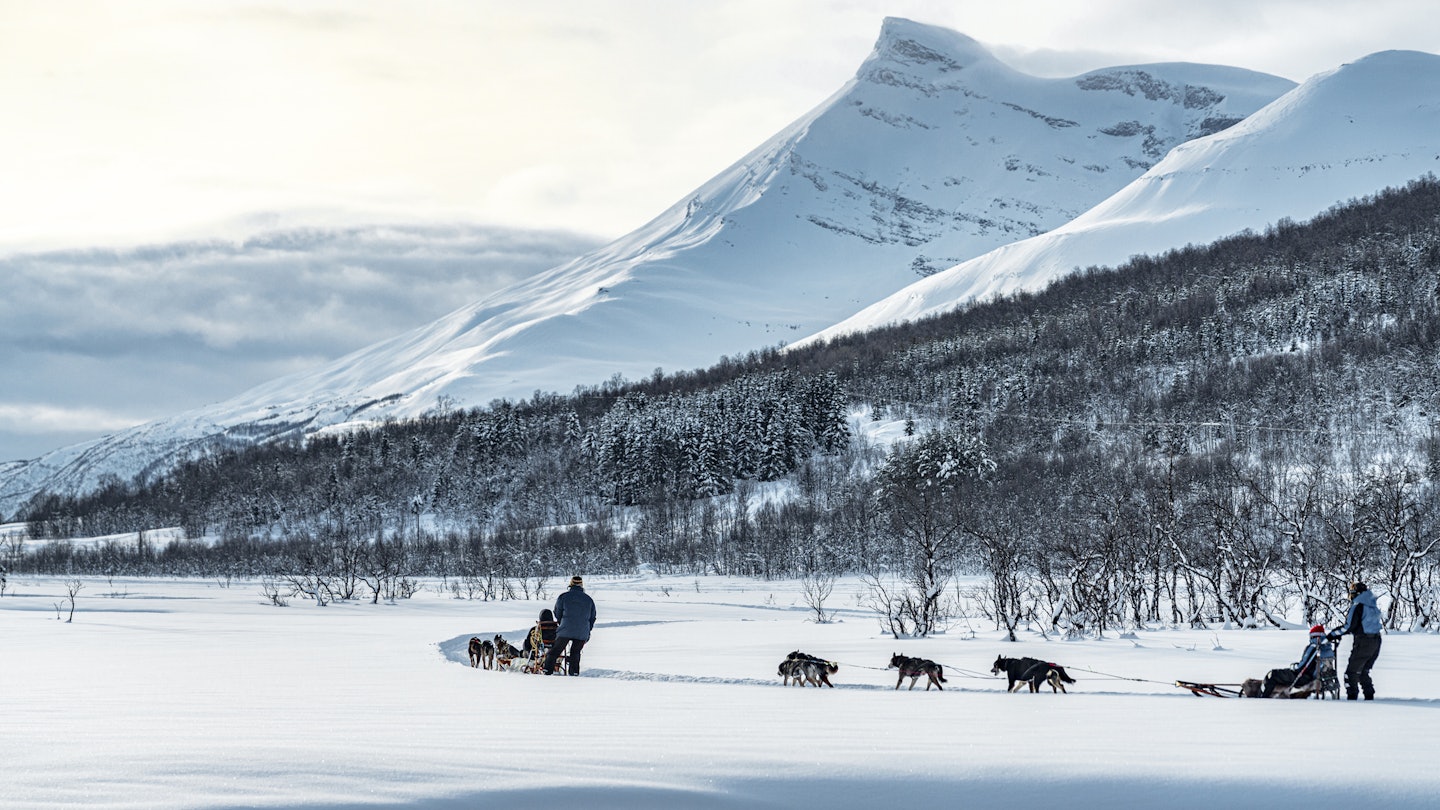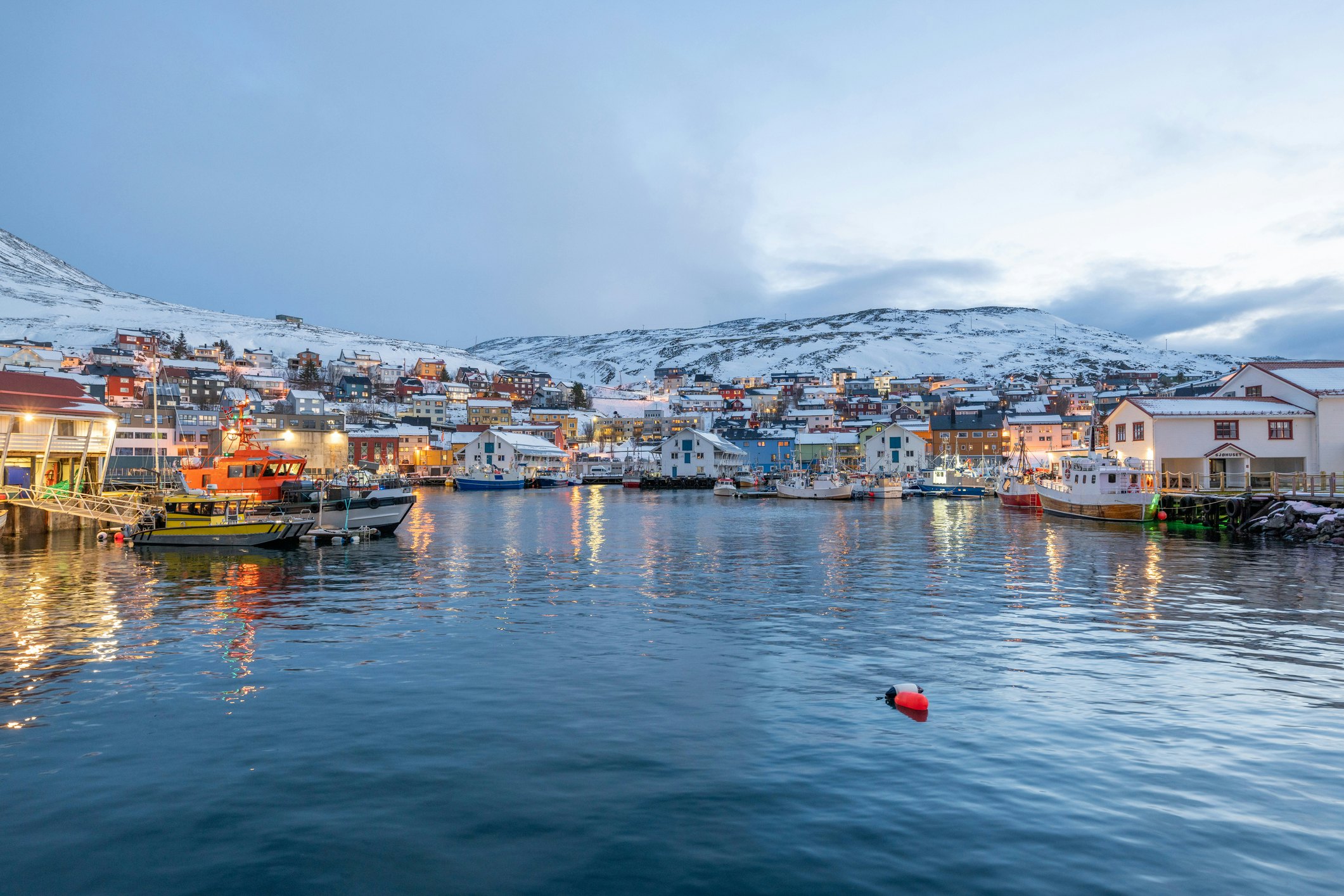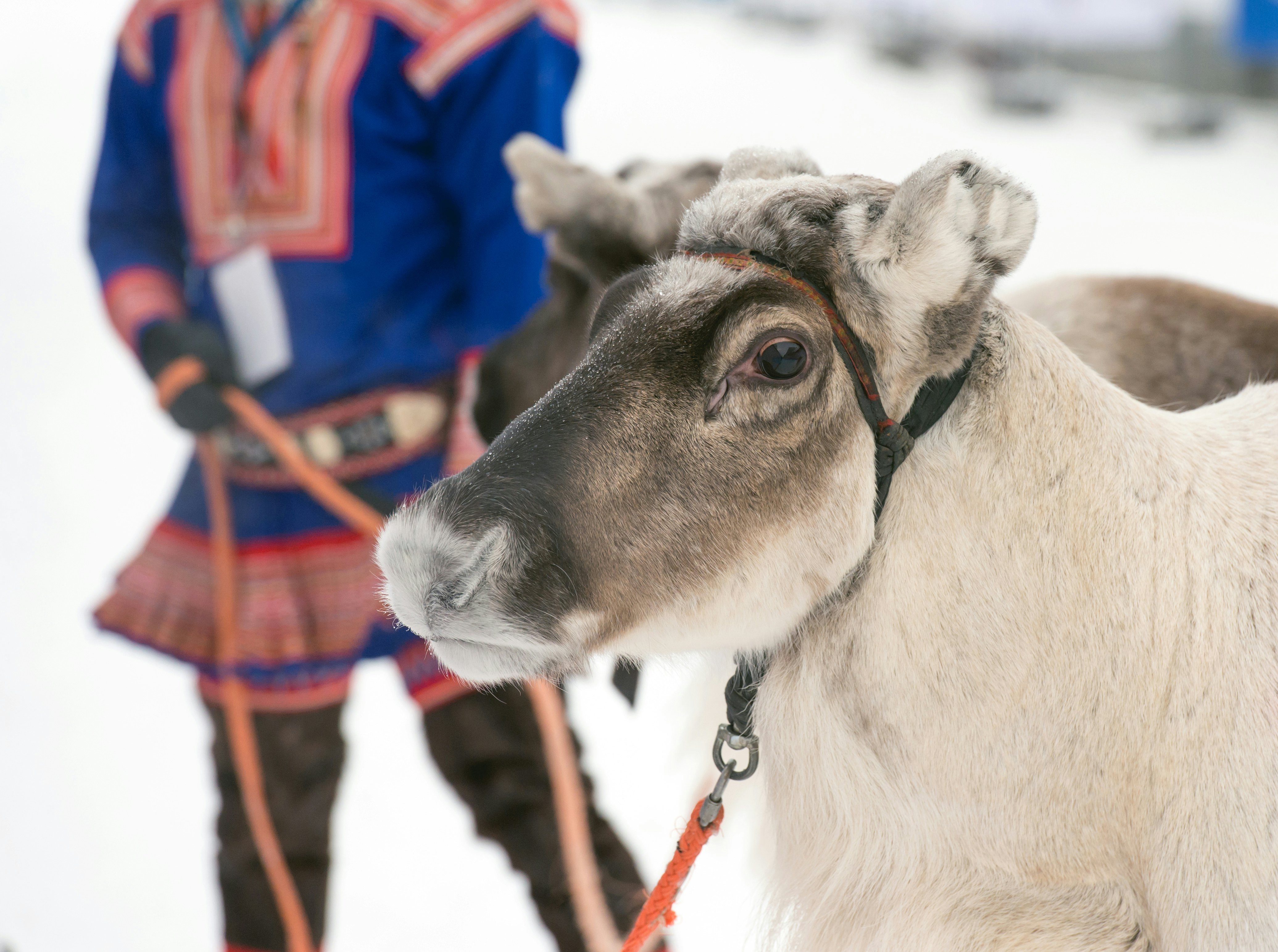
The 30 best countries, cities and regions to visit in 2025
Feb 10, 2025 • 11 min read

Arctic Norway is everything you'd hope for from the frozen north. Roberto Moiola/Getty Images
For an unforgettable road trip through some of Europe’s most remote and breathtaking scenery, embark on a week-long adventure through Arctic Norway – the most rugged corner of Scandinavia’s frozen north. In the land of the midnight sun and northern lights, memorable experiences are guaranteed!
Spanning the Norwegian counties of Troms and Finnmark, this epic journey takes you through stunning Arctic landscapes, from soaring mountain peaks to glacier-carved fjords and wide, open tundra. There’s culture to discover, too, from Indigenous Sami heritage to Viking relics and traces of Russian influence. This region’s history is as vast as its wild beauty.
Starting in the lively Arctic city of Tromsø and ending in Karasjok, the hub of the Sami community in Norway, this seven-day road trip spans scenic drives, trips to remote villages and fascinating cultural stops. Along the route, you’ll visit historic sites, experience local Sami traditions, and (if you’re lucky and time it right) witness the northern lights.
Whether you’re exploring picturesque fishing villages, hiking through pristine areas of wilderness, or simply sitting back to soak in the natural beauty, this week-long itinerary through Arctic Norway promises an unforgettable journey.
Here’s how to take in Arctic Norway’s jaw-dropping fjords, dramatic coastlines and expansive skies.

The milder summer months are the ideal time for a long road trip to discover the dramatic landscapes and remote townships of Arctic Norway. However, the icy winter is the best time to visit if you hope to see the northern lights, or go whale watching or dog-sledding. Wrap up warm, as nighttime temperatures can drop as low as -14°C (7°F) in mid-winter.
Tromsø Airport at Langnes is the main gateway to Arctic Norway, and there are several ways to get into the center of Tromsø city, including local buses, taxis and the Airport Express coach service, which takes about 15 minutes. You can also rent a car and start your road trip right from the airport.
You’ll need a car to fully explore Arctic Norway. With vast distances and remote locations to cover, this is a very challenging region to explore using Norway’s public bus system. Ensure your hire car is up to the challenge of the Norwegian climate; winter tires are provided on rental vehicles from October to the end of April, but you’ll need to make a special request for a vehicle with studded tires.
Wildlife rules the road here, so watch out for wandering reindeer and other wildlife on the highways. And if driving in winter, anticipate harsh, icy conditions and drive cautiously and slowly. When planning your trip, build a few extra days into your itinerary to account for the lengthy drives.
Norway's weather can be cold and unpredictable, so it's important to pack warm layers, including thermal underwear, fleece tops and a warm, windproof jacket. For everyday wear, Norwegians tend to dress smart-casual, so bring comfortable but presentable clothing for visits to restaurants and drinking spots.
Sturdy, weatherproof walking shoes or boots are essential for both mountain hikes and city sightseeing, particularly in winter. From spring to fall, you’ll want to pack a light rain jacket for the occasional shower. And don’t forget a reflective patch, arm-band or jacket so you are visible to traffic during the long, dark winter evenings.

How to spend the day: Start your Arctic adventure in Tromsø, the "Capital of the North," and explore its charming city center on foot. Begin with a stroll along the lively shopping street of Storgata, popping into Tromsø Domkirke church, which dates back to 1861. From here, make your way to the havn (harbor), where you’ll catch sight of moored fishing boats and Arctic expedition vessels.
As you continue along the harbor, swing by the Polar Museum, housed in a 19th-century warehouse. Here, you can dive into the history of the Arctic, from the days of fur-trapping to the pioneering expeditions of Nansen and Amundsen, and view fascinating artifacts and historic photos. There are numerous lunch stops in and around the harbor.
Before leaving the waterfront, take a walk around the colorful wharf houses and explore the recently developed Vervet area. Finish a day of sightseeing by crossing the iconic Tromsøbrua (Tromsø Bridge) to admire the Ishavskatedralen (Arctic Cathedral), a modernist triangular structure inspired by the surrounding mountains.
Evening: Year-round, the nightlife booms around Storgata and the Vervet area. Chic bars serve cool cocktails and locally brewed beer, and restaurants prepare traditional Norwegian cuisine, all within a 20-minute walking radius of the harbor.

Morning: With a busy day ahead, start off at Risø, located in the city center, for the best coffee and cinnamon buns in town.
How to spend the day: From November to January, Tromsø’s fjords are a hotspot for whale watching, as orcas and humpback and minke whales flock here to feast on migrating herring. Whale-watching tours offer an incredible opportunity to get up close to these majestic creatures.
Several companies run daily trips from the ferry terminal near Nerstranda, a five-minute walk from the main harbor. Be sure to clear your schedule for the day, as tours can last up to eight hours, depending on where the whales are feeding.
For the most intimate experience, hop on board the hybrid boat operated by Brim Explorer, which uses electric power when near the whales, ensuring a calmer and more respectful viewing experience for everyone.
If you’re visiting Tromsø outside of the whale-watching season, spend a few hours at the Tromsø University Museum. Here, you’ll find fascinating exhibits on everything from traditional and modern Sami life to ecclesiastical art and Viking history. Downstairs, explore thought-provoking displays on the region’s geology and pressing environmental issues, such as global warming and the loss of wilderness habitats.
Don’t miss the “northern lights machine” that lets you experience a mini version of the aurora borealis. In the garden, you’ll find a traditional Sami gamme (turf hut), where you can enjoy free coffee in the summer months. And look out for the hourglasses that were once used to signal to local preachers when their sermons were running long!
Evening: To see the northern lights for real, you’ll need to visit between late August and early April. Take the Fjellheisen cable car for the best views; rising to 421m (1381ft) above sea level, it offers dazzling Tromsø vistas during the journey up Mt Storsteinen. Head up after 6pm and check Norway-lights.com for the most up-to-date aurora forecasts.

Go from Tromsø to Alta: On day three, make your way to Alta, about 221km (137 miles) northeast of Tromsø. The drive takes 5 hours and 45 minutes, so head off early to reach Alta in time to see some of the sights.
How to spend the day: If you reach Alta in daylight, visit the cliffs around the Alta Museum. A UNESCO World Heritage Site, these crags are incised with thousands of rock carvings, created 6000 to 2000 years ago and only rediscovered in the 1960s.
Etched into the bedrock, these astonishing petroglyphs depict scenes of Stone Age life, with depictions of animals such as bears, cormorants and fish, as well as human figures and boats. You can follow a 1.2km (0.75-mile) boardwalk loop or a 3km (1.8-mile) walking trail around the site; keep an eye out for moose as you wander.
How to spend the day: As the setting for Europe’s longest dog-sled race, the Finnmarksløpet, Alta is an ideal spot to experience a form of transport that has been used in the Arctic since the 10th century BCE. The best time to go dog-sledding is during the late winter and early spring months, although summertime sledding on wheeled carts is also an option.
Holmen Husky Lodge is a family-run dog-sledding business with tours that last from 2½ to 5 hours. They also offer some enticing accommodations, including a lavvu (Sami tent dwelling) from where you can enjoy views of the northern lights in season.
If your visit falls outside the dog-sledding season, spend the day at the Alta Museum, which features fascinating exhibits on Sami culture and local history, then step outside to explore the 6000 ancient petroglyphs etched into the cliffs.
Evening: To combine a day of dog-sledding with gastronomic delights, head to Trasti og Trine, a dog-sledding center and restaurant that focuses on local produce from the surrounding mountains, forest and sea. A variety of cooking courses are also available, starting at 152kr (US$13).
Planning tip: For a memorable stay in Alta, hunker down at the Sorrisniva Igloo Hotel, rebuilt every year using ice from Sierravann lake and carved by local artists and sculptors. It’s typically open from December 20 until April 7 for overnight stays and visits.

Go from Alta to Honningsvåg: Get an early start for the stunning 3.5-hour drive along beautiful Porsangerfjorden to the island of Magerøya and Nordkapp, Europe’s northernmost point. There’s plenty to see before you roll into Honningsvåg for the night.
How to spend the day: From Alta, follow the Arctic Highway (E6) across wide plains towards Olderfjord, where you’ll peel left onto the E69 and pass through 125km (78 miles) of mesmerizing coastal landscapes. Take your time and enjoy the views over Porsangerfjorden to the east.
You’ll pass through the 7km-long (4.3-mile) Nordkapptunnelen to reach Magerøya island. Follow the road to the left to get to the dramatic drop-off at Nordkapp, where cliffs plunge 307m (1007ft) into the Arctic Ocean. It’s a bustling spot for visitors, and you’re closer to the North Pole than Oslo.
On your way back, bear east towards Skarsvåg, Europe’s northernmost fishing village. This quaint spot is perfect for fishing fans, with local fishers offering daily tours to catch cod, halibut and king crab. Afterward, enjoy a hearty homemade meal at timber-lined Daniels Hus.
Next, take a 30-minute drive west through tundra dotted with dark pools and reindeer to reach Gjesvær. This beautiful fishing village is the launch point for a two-hour bird safari to Gjesværstappan Nature Reserve, with three departures daily. The reserve is home to one of Europe’s largest puffin colonies, and you’ll get a unique perspective on the northernmost point in Europe from the ocean.
Evening: Continue to the town of Honningsvåg for the night, and dine at Arctic Sans – this is where locals eat, and it’s one of the best restaurants in town. Or, if you’re feeling brave, try a traditional dish of cod tongues at Corner Spiseri, the oldest restaurant in town.
Planning tip: While the trip from Alta to Honningsvåg can be completed in one day, it’s more rewarding when spread over two or three days, and there are plenty of accommodation options. To immerse yourself in the scenery, consider a rustic camping experience at Nordkapp Camping to the south of Skarsvåg. Or for a more luxurious stay, book a room at The View in Honningsvåg, which offers stunning panoramic vistas and an in-house spa for a truly relaxing experience.

Morning: Kick off your day in Honningsvåg at Honni Bakes, a central French-style bakery, for coffee, fresh bread, pastries and homemade chocolate.
How to spend the day: Start by taking a hike up 310m (1000ft) Storfjellet. The climb is a bit steep, but the stone steps make it manageable and the views at the top are worth all the effort. From the summit, you can take in a breathtaking panorama of the town and harbor.
Once you’ve finished admiring the scenery, head back to town and stop by Honningsvåg Church, the only building in town to survive WWII. This neo-Gothic gem offers a peaceful spot for reflection in a striking piece of Scandinavian wooden architecture from 1885.
If you’re interested in learning more about the town’s history, the Nordkappmuseet by the quay is a great spot to explore. It documents the town’s wartime past and the incredible resilience of the local community as they rebuilt Honningsvåg after the conflict.
Evening: Off Sjøgat, you’ll find the rustic Sjøgata Pub, which serves beer from its own brewery. Above it is Perleporten Kulturhus, which hosts the popular Our Northernmost Life theater show in June, the lively Oggasjakka music festival in August and the Nordkapp Film Festival in September

Go from Honningsvåg to Karasjok: Day seven starts with a drive of 3.5 hours to Karasjok, where you can end your road trip in the heartland of Sami culture.
How to spend the day: Once you reach Karasjok, take a guided tour of the Sami Parliament (Sámediggi), a stunning larch-clad construction surrounded by tall pine trees. This building is the hub of Sami culture in Norway; you’ll spot its summit-like, timber-clad rooftop through the trees as you approach.
Inside is the Vandrehallen, a large foyer and library; its design was inspired by the night sky and the northern lights. The library houses Norway’s largest collection of Sami-language books, and you can view some interesting historical artifacts, including the signature that King Olav inscribed on a reindeer hide when the first Sami parliament opened in 1989. Tours of the building run at 1pm on Tuesdays, Wednesdays and Thursdays.
For more insights into Sami life, spend some time exploring the Sami National Museum (De Samiske Samlinger) to learn about the culture and traditions of Norway’s Indigenous people. Be sure to check out the displays on duodji (Sami handicrafts) and joik (traditional Sami singing). Outside, several traditional buildings show how the Sami lived in this region before the advent of modern technology.
Evening: Wrap up your week-long tour around Arctic Norway by trying traditional Sámi cuisine made with locally sourced ingredients such as reinsdyrstek (reindeer meat) and cloudberries, at Sápmi Park's Restaurant Storgammen (June to August only).
This article was adapted from the Lonely Planet Norway guidebook published in April 2024